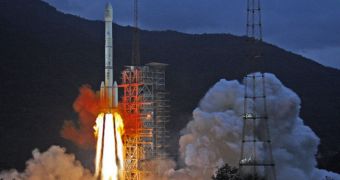Officials with the Chinese National Space Administration (CNSA) announce that their new lunar orbiter has just achieved orbital injection around the Moon yesterday, October 6.
The spacecraft managed to successfully complete an intricate aerobrake maneuver, that ensured it remains in a correct orbit around Earth's natural satellite. This was a critical milestone in the new mission.
Chang'e 2 took off on October 1, at 1059 GMT (6:59 EDT), from the Xichang Space Center, in the Sichuan province of southwestern China, and is the second spacecraft from its series.
It took five days to travel from Earth to the Moon, and it is now inscribed in a 12-hour orbit. This is however not its final perch. Two additional maneuvers are required to set the satellite into its final orbit.
According to China's Xinhua News Agency, the aerobraking maneuver took place flawlessly, decelerating the spacecraft sufficiently to allow for it to enter an elliptical orbit, which will eventually convert into an 118-minute one.
The Beijing Aerospace Control Center said in a news release accompanying the announcement that the successful maneuver ensures that Chang'e 2 will be able to conduct high-resolution scientific observations of the lunar surface.
In the first stage of the mission, the satellite will orbit some 60 miles (100 kilometers) above the Moon's surface, but it will eventually descend to a lower altitude, of just 9 miles or 15 kilometers.
Chang'e 2 represents the second of the Chinese lunar exploration program. Current plans call for Chang'e-3 to land on the Moon by no later than 2013, ad authorities are convinced this is possible.
“As a major country, China has the responsibility to participate in the activities of outer space for peaceful use and make its own contributions,” told Xinhua expert Qian Weiping.
He is the chief designer of the tracking and control systems that enable Chang'e 2's operations, Space reports.
With the new launch, China marks a new stage in its space exploration plans, which are more ambitious than any country's today. They include putting men on the Moon, and building a space station.
The idea about building a new orbital facility came after the first successful spacewalks and manned launches. Officials with CNSA believe that a space station is possible if a demonstration flight later this year is successful.

 14 DAY TRIAL //
14 DAY TRIAL //